Stand-Alone Lessons and Activities
Jewish Values: Klal Yisrael – Peoplehood
Peoplehood / World Jewish Community- Klal Yisrael ( )
Engage students in one or more of the following activities to explore the Jewish value of Klal Yisrael – Peoplehood:
-
Have students complete Worksheet N, or explore the photograph, questions, and texts on the worksheet together through class discussion.
-
Have students look at the Photograph Honorable Discharge and write a story from the point of view of the figure in the picture. (See the photo caption for more information about the photograph and its historical context.) Afterward, share and discuss:
-
What do people imagine is the story of this man?
-
How do you think he feels? Why?
-
How would you feel in his situation?
-
What does it mean for Israel to be your “Homeland” if you’re from somewhere else?
-
-
View and discuss the photographs The Secret, Backpack, Cave, Barefoot Passages, Let My People Go, The Shape of Sound, Background, Open Table, and B’nei Menashe, as well as the individuals and communities depicted in them. Then have students research the various aliyot (immigrations) to Israel in the 20th century they represent—from Ethiopia, Yemen, North Africa, the former Soviet Union, and elsewhere.
-
Have students take photographs in school, at home, or in the community that reflect the value of klal yisrael, or have them create and photograph a series of “tableaux”—staged scenes—that depict the value. Share and discuss.
-
What was challenging about this assignment?
-
How does your photograph reflect klal yisrael? Is it possible to capture this value fully in a photograph?
-
What is similar or different among the various photographs students took?
-
What title would you give your photograph? Why?
-
PHOTOS

Honorable Discharge, Ben-Gurion Airport, Israel, 1992
Look at the expression on this man’s face. How would you describe it—fear, sadness, confusion, joy? He has just arrived in Israel from the former Soviet Union. Under communism, Soviet Jews were not allowed to practice their religion openly and were often denied the right to immigrate to the U.S. or Israel. But after Gorbachev (the Soviet president) opened the doors to emigration in 1989, hundreds of thousands of Jews from the former Soviet Union flocked to Israel, with the help of Jews around the world.
These immigrants often arrived with very little and faced many challenges in their new homes. But the man in this picture has brought something very precious with him: the military medals he wears with pride. They serve as a reminder of his previous life, of the risks he took fighting for his country.
Here is what the photographer, Zion Ozeri, has to say about this picture: “I call it honorable discharge. He was obviously discharged from the Russian army. And many Jews, by the way, either sacrificed their lives or fought heroically during World War II…. I always look for the image that would define the moment, so to speak. So I sort of saw it in his face…. You see the flag, you see El-Al, and that look.”
Sample Texts:
; , .
Gray hair is a crown of glory;
It is attained by the way of righteousness.
– Proverbs (Mishlei) 16:31
, .
Bring us in peace from the four corners of the earth and lead us with upright pride to our Land.
– from shacharit (the morning service)
- , -; - -, - . --, - , , ; , -, , .
Assuredly, a time is coming—declares the Lord—when it shall no more be said, “As the Lord lives who brought the Israelites out of the land of Egypt,” but rather, “As the Lord lives who brought the Israelites out of the northland, and out of all the lands to which He had banished them.” For I will bring them back to their land, which I gave to their fathers.
– Jeremiah (Yirmiyahu) 16:14-15
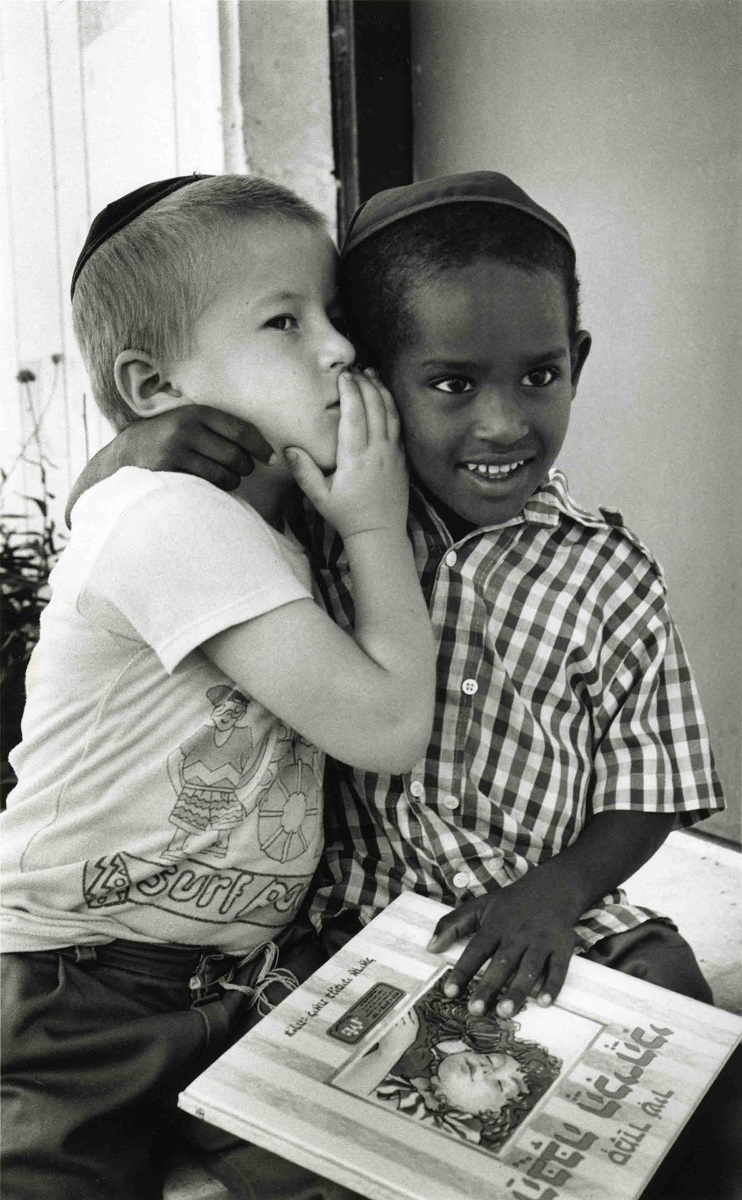
The Secret, M’vaseret Zion, Israel, 1990
During the 1980s and 1990s, many Jews came to Israel from Ethiopia and the former Soviet Union for religious freedom and a better life. These immigrants often lived in special apartment buildings, called “absorption centers,” until they could find more permanent homes. Absorption centers provide temporary housing and an introduction to Israeli life for many new immigrants. The photographer, Zion Ozeri, explains how important these centers are: “The first few steps of any immigrant are very difficult—not knowing the language, not knowing where to buy things, where to go. The Absorption Center helps the new immigrant. It’s something I don’t know if they have anywhere else in the world. It’s a place where you can ease yourself into it. For the first few months at least, they give them some money to buy food, and there is an ulpan(Hebrew class) for teaching the language. They kind of initiate them into new life in Israel, and how to deal with everyday things from the very, very simple things—like shopping in the supermarket—to finding a job.”
The two boys in this picture are in a kindergarten class at an absorption center near Jerusalem. One boy is from Ethiopia; the other is from the former Soviet Union.
Sample Texts:
When two people relate to each other authentically and humanly, God is the electricity that surges between them.
– Martin Buber
One day, [Honi] was walking along the road, and he saw a man planting a carob tree. He asked him, “How long does it take [for this tree] to bear fruit? The man replied, “Seventy years.” He asked him further, “Are you certain you will live another seventy years?” The man replied, “I found the world provided with carob trees because my forefathers planted them for me. I am planting them now for my children.”
– Babylonian Talmud, Taanit 23a
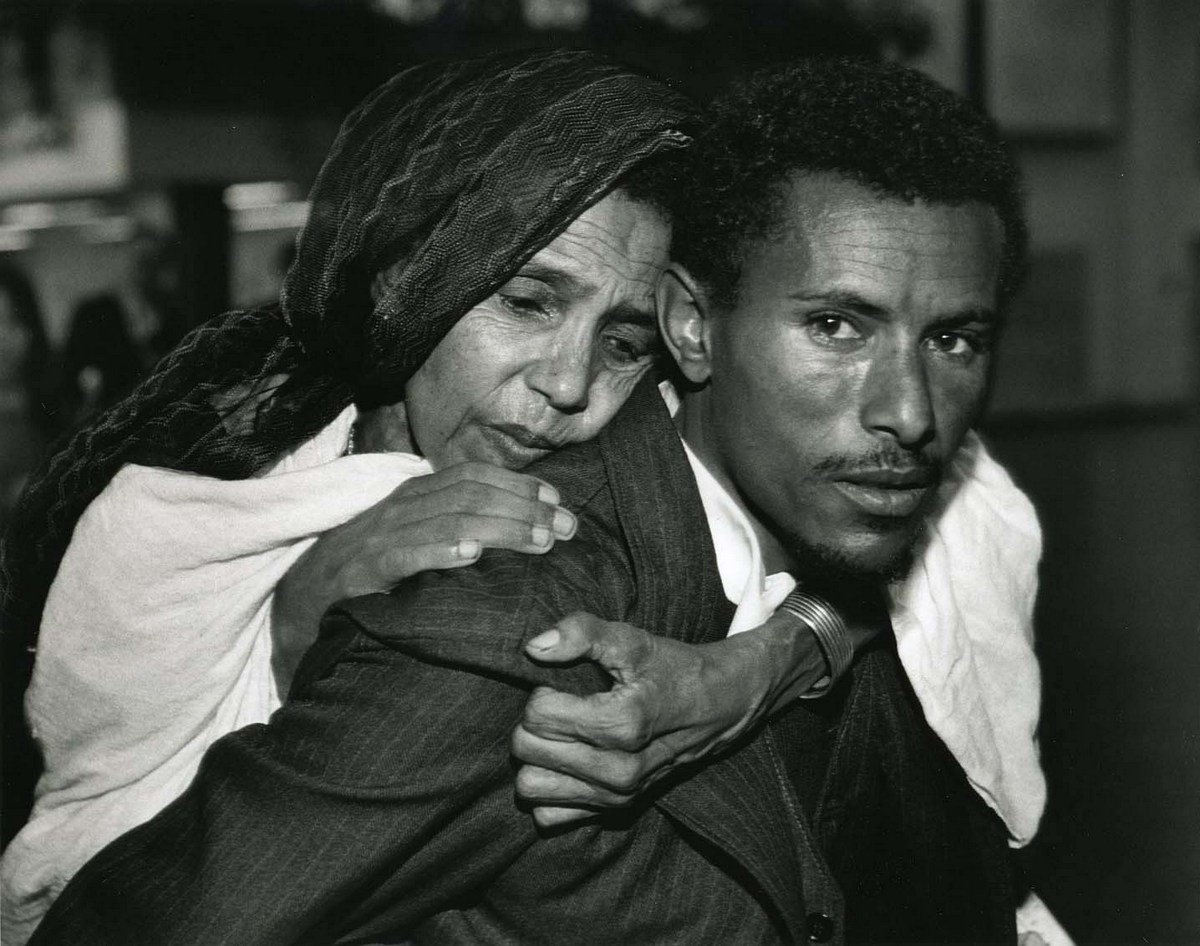
Backpack, Ben Gurion Airport, Israel, 1991
Jews have lived in Ethiopia for hundreds and hundreds of years. But in the 1970s and 1980s, life became very difficult for them. They were no longer safe. So, in 1984, the Israeli government organized a secret operation—known as Operation Moses—to bring Ethiopia’s Jews to Israel. In six short weeks, almost 8,000 Ethiopian Jews were rescued through the Sudan. It was a difficult journey, and many suffered or died along the way. When the operation ended, about 15,000 Jews still remained in Ethiopia.
In 1990, Israel and Ethiopia reached an agreement that would allow Ethiopia’s remaining Jews to move to Israel. But before anything could be done, rebel forces threatened to topple the Ethiopian government. So in May 1991, as the rebels seized control of Ethiopia’s capital, the Israeli government organized an unprecedented rescue operation, called Operation Solomon. Beginning on Friday, May 24, and continuing non-stop for a day and a half, 36 El-Al jumbo jets and military transport planes carried more than 14,000 Ethiopian Jews to freedom in Israel.
The people in this photograph were part of Operation Solomon. The man carries his mother on his back as they enter the land of Israel for the first time. Look at the expression on their faces. How do you think they feel?
Here’s what the photographer, Zion Ozeri, had to say about the experience: “I was here [in the United States] at the time. Reading carefully through the Israeli newspapers and the New York Times, I felt that something was going to happen—some kind of an airlift. I smelled it in the air. So I called someone I knew at the Jewish Agency in Jerusalem, and I said, ‘What’s happening? Is it what I think is going to happen? Is there going to be an airlift?’ He said, ‘Are you crazy? I can’t talk to you about this over the phone.’ I said, ‘I understand. But tell me, should I just buy a ticket to come to Israel right now?’ And he said, ‘Yeah.’ I bought a ticket and I got there Friday afternoon. I put my luggage down at my parents’ house, took my camera, and said, ‘Goodbye, I’m going back to the airport.’ They said, ‘Why?’ I said, ‘I can’t tell you now, but you’ll know in a couple of days.’ And it was the most amazing thing. An hour or two after I got to the airport, they started landing. And you’d see babies who were being born on the planes. It was just amazing.”
Sample Texts:
.
All people, in every generation, must regard themselves as having been personally freed from Egypt.
– from the Passover Haggadah
My son, heed the discipline of your father,
And do not forsake the instruction of your mother.
For they are a graceful wreath upon your head,
A necklace about your throat.
– Proverbs (Mishlei) 1:8
And Moses said to the Lord, “Why have You dealt ill with Your servant, and why have I not enjoyed Your favor, that You have laid the burden of all this people upon me? Did I conceive all this people, did I bear them, that You should say to me, ‘Carry them in your bosom as a nurse carries an infant,’ to the land that You have promised on oath to their fathers?”
– Numbers (Bemidbar) 11:11-12
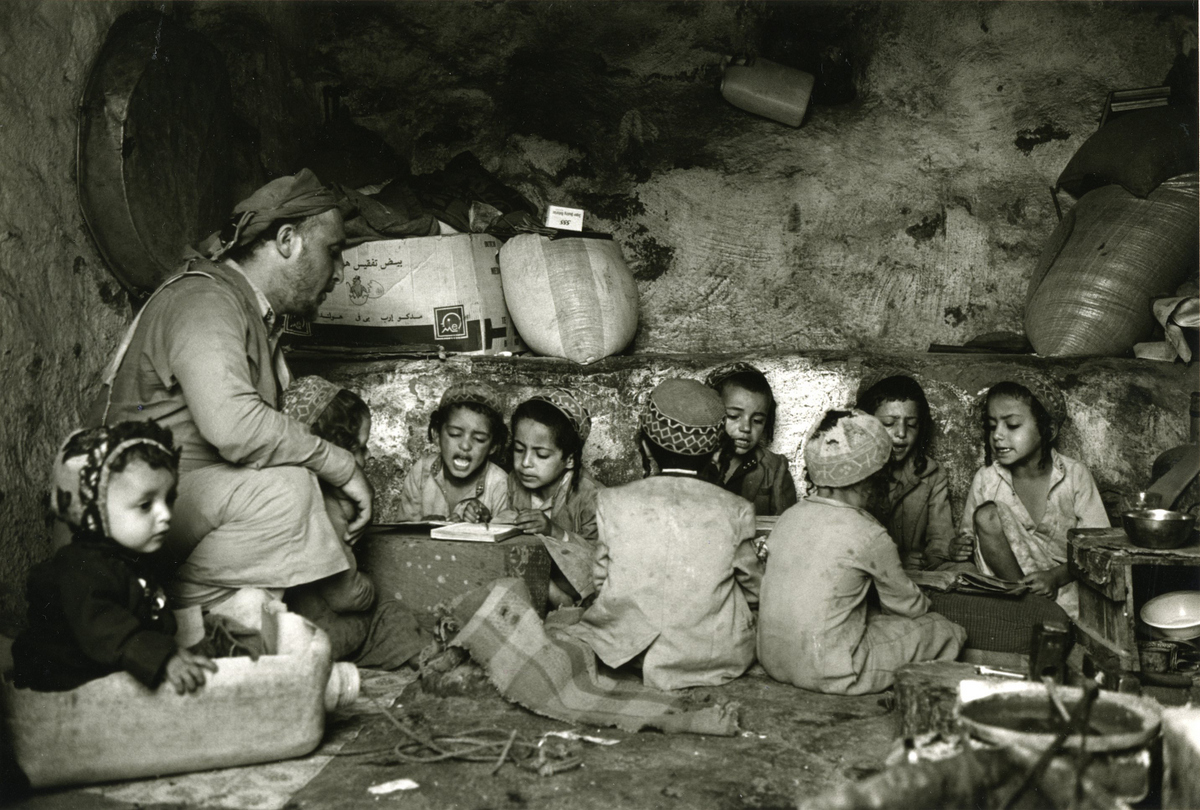
Cave, Haidan A-Sham, Yemen, 1992
You don’t need to be in a classroom or synagogue to study the Torah. You can do it almost anywhere—even in a cave. The town of Haidan A-Sham is located in a rugged and mountainous part of Yemen, and the Jews there made use of whatever spaces were available. These boys have gathered in a cave to study the weekly Torah portion. Since the time this photo was taken, most of the Jews have left that part of the country, moving to bigger cities or to Israel.
Jews first moved to Yemen in ancient times. They practiced their religion faithfully throughout the centuries but were generally treated as second-class citizens by the Muslim authorities. Because of the way they were treated, as well as their longing to return to the Jewish homeland, Yemenite Jews started immigrating to Israel in the late 1880s. This culminated in 1949 – 50 with a huge airlift known as Operation Magic Carpet. For the Yemenite Jews, this airlift seemed to fulfill Isaiah’s prophecy that the Jewish people would be brought to the promised land “on the wings of eagles.” Today, only a tiny number of Jews remain in Yemen.
Sample Texts:
, , , , . : , ,
At Sinai Moses received the Torah and handed it over to Joshua who handed it over to the elders who handed it over to the prophets who in turn handed it over to the men of the Great Assembly. The latter said three things: Be deliberate in judgment, raise up many disciples, and make a fence around the Torah.
– Pirkei Avot 1:1
, , ; .
Joshua ben Perachyah said, “Get yourself a teacher, find someone to study with, and judge everyone favorably.”
– Pirkei Avot 1:6
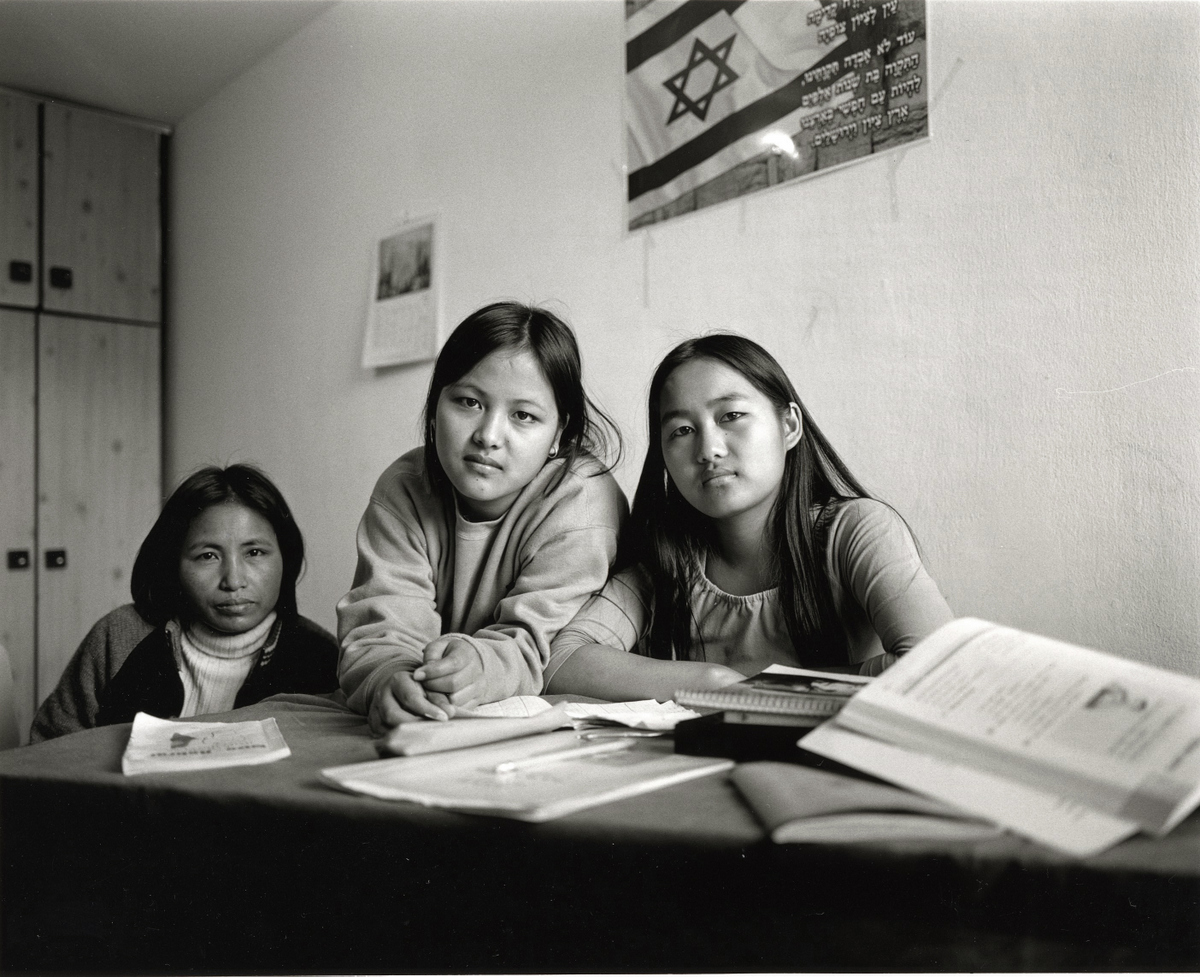
B’nei Menashe (Immigrants from India), Carmiel, Israel, 2007
This photograph was taken at an absorption center for new immigrants in Israel. The subjects of the photo are members of the B’nei Menashe(Children of Menashe), a small group of people from northeast India whose traditions bear similarities to Jewish practice and who believe they are descended from the ancient Israelite tribe of Menashe. They trace their history to the exile of the Northern Kingdom of Israel in 721 BCE, across Asia to China, and finally to India. In recent years, small groups of B’nei Menashe have immigrated to Israel, officially converted to Judaism, and begun to learn about traditional Jewish practice.
Sample Texts:
-, -, , ; , .
The Angel who has redeemed me from all harm—
Bless these boys.
In them may my name be recalled,
And the names of my fathers Abraham and Isaac,
And may they become numerous throughout the earth.
– From Jacob’s blessing over his grandchildren, Ephraim and Menashe, Genesis (Bereshit) 48:16
As long as deep in the heart
The soul of a Jew yearns
And towards the East
An eye looks to Zion
Our hope is not yet lost
The hope of two thousand years
To be a free people in our land
The land of Zion and Jerusalem.
– Naphtali Hertz Imber
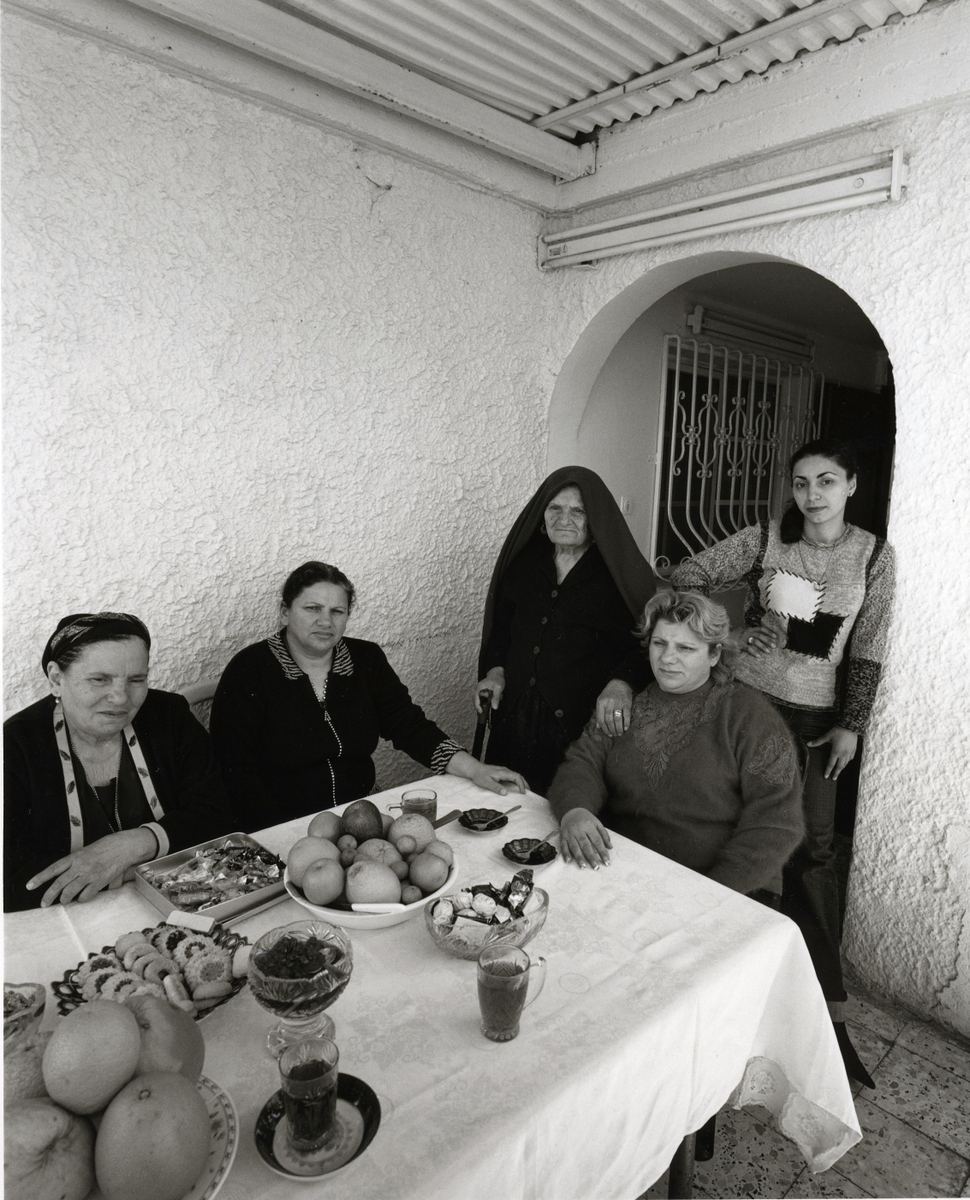
Open Table, (Immigrants from Azerbaijan), Acco, Israel, 2007
Members of the Kavkazi community (Jews from the Caucasus Mountains of southern Russia and Azerbaijan) who have immigrated to Israel have strived to retain important aspects of their rich cultural heritage. This photograph reflects one example of this—the value of hospitality that is central to their tradition. The woman in the middle (with her head covered) represents another cultural attribute among the Kavkazi Jews—the reverence and respect that is paid to matriarchs and patriarchs in the community. The photograph, however, also reflects a certain tension among the Kavkazis—the tension between tradition and modernity, as expressed in the different clothing styles of the younger and older women.
Sample Texts:
When the great calamity befell Job, he pleaded with the Holy One, “Master of the Universe, did I not feed the hungry, give drink to the thirsty, and clothe the naked?”
The Holy One answered Job, “Job, you have not yet reached half the measure [of hospitality] extended by Abraham. You sat in your house waiting for guests to come to you. To him who was accustomed to eat wheat bread, you gave wheat bread; to him who was accustomed to drink wine, you gave wine. But Abraham did not act thus. He went out, getting about in the world. When he met prospective guests, he brought them to his home. Even to him who was not accustomed to eat wheat bread, he gave wheat bread; to him who was not accustomed to eat meat, he gave meat; and to him who was not accustomed to drink wine, he gave wine.”
-Avot of Rabbi Natan 7
When Rav Huna had a meal, he would open the doors of his house and say, “Let whoever is in need come and eat.”
– Babylonian Talmud, Taanit 20b 21a
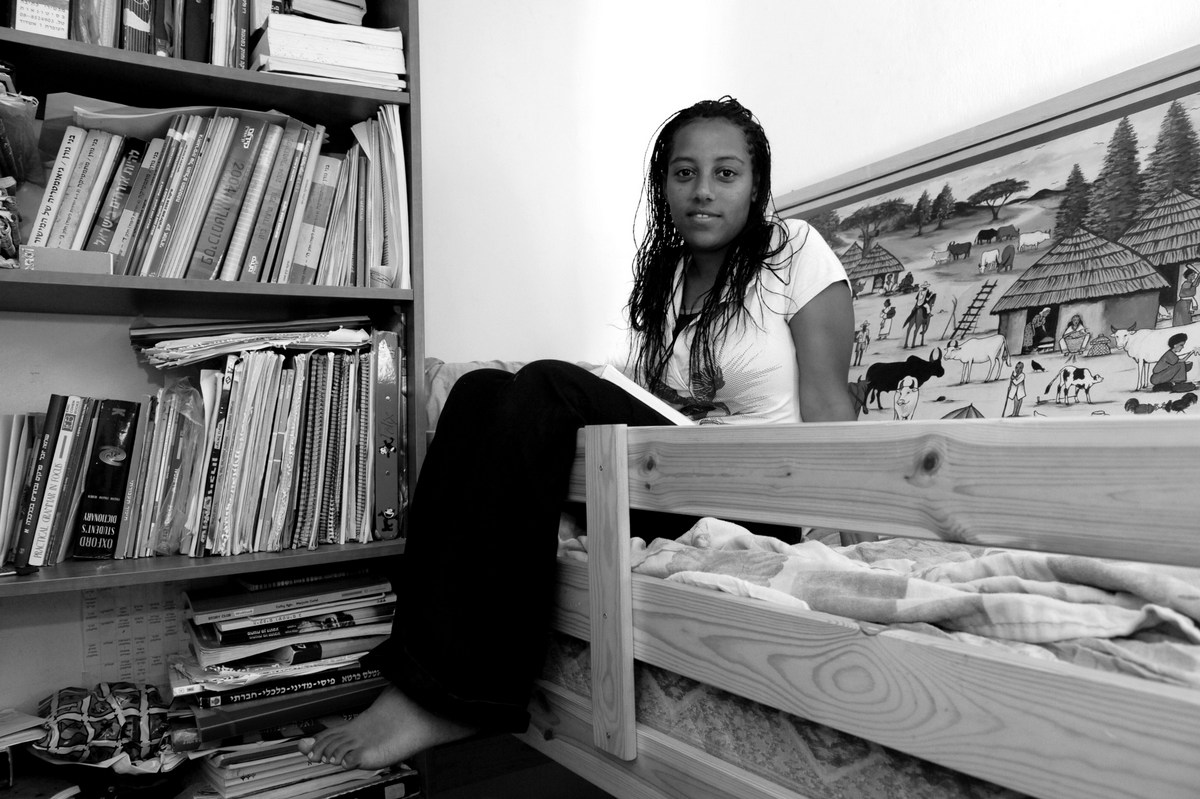
Background, Rehovot, Israel, 2008
A teenager sits on her bed in the Israeli town of Rehovot. Her schoolbook is open on her lap, her shelves strewn with other books and assorted knickknacks. This could be any teenager’s room anywhere in the world. But the poster on the wall above the bed reflects this girl’s unique cultural heritage.
It shows daily life in a small village in Ethiopia. It’s a life that’s far removed from her modern existence in Israel. This young woman is one of about 85,000 Ethiopian Jews in Israel. Her parents made the difficult journey from Ethiopia during the mass migrations of the 1980s. But the journey did not end when they reached Israel.
All immigrants must struggle to adjust to a new home, new language, new friends, new culture. But those coming from Ethiopia have also had to make the transition from living in a developing nation to life in an industrialized one. In addition, the religious life of the Ethiopian Jews developed independently of mainstream Judaism over the centuries, and their re-absorption into the larger Jewish community has not always been smooth. Today, the Ethiopian Jewish community in Israel continues to face challenges, especially in the areas of education and employment.
Sample Texts:
The whole world is one town.
– Yiddish saying
, - - - - , , ; , .
But take utmost care and watch yourselves scrupulously, so that you do not forget the things that you saw with your own eyes and so that they do not fade from your mind as long as you live. And make them known to your children and to your children’s children.
– Deuteronomy (Devarim) 4:9
The individual understands himself or herself in terms of a community, not only as a singular independent person but also as an individual attached to others and interdependent with them. Here, identity means identification: solidarity with others with whom you identify. Identity in this sense is a kind of communal self.
This tie to community in the past, the present, and the future is what adds a further dimension to your own immediate activities. It requires that you not simply engage the world as a lone individual. What you do contributes to a larger picture: linking your life to the lives of contemporaries who are part of the same community or to past and future generations of that community.
– Natan Sharansky, Defending Identity: Its Indispensable Role in Protecting Democracy
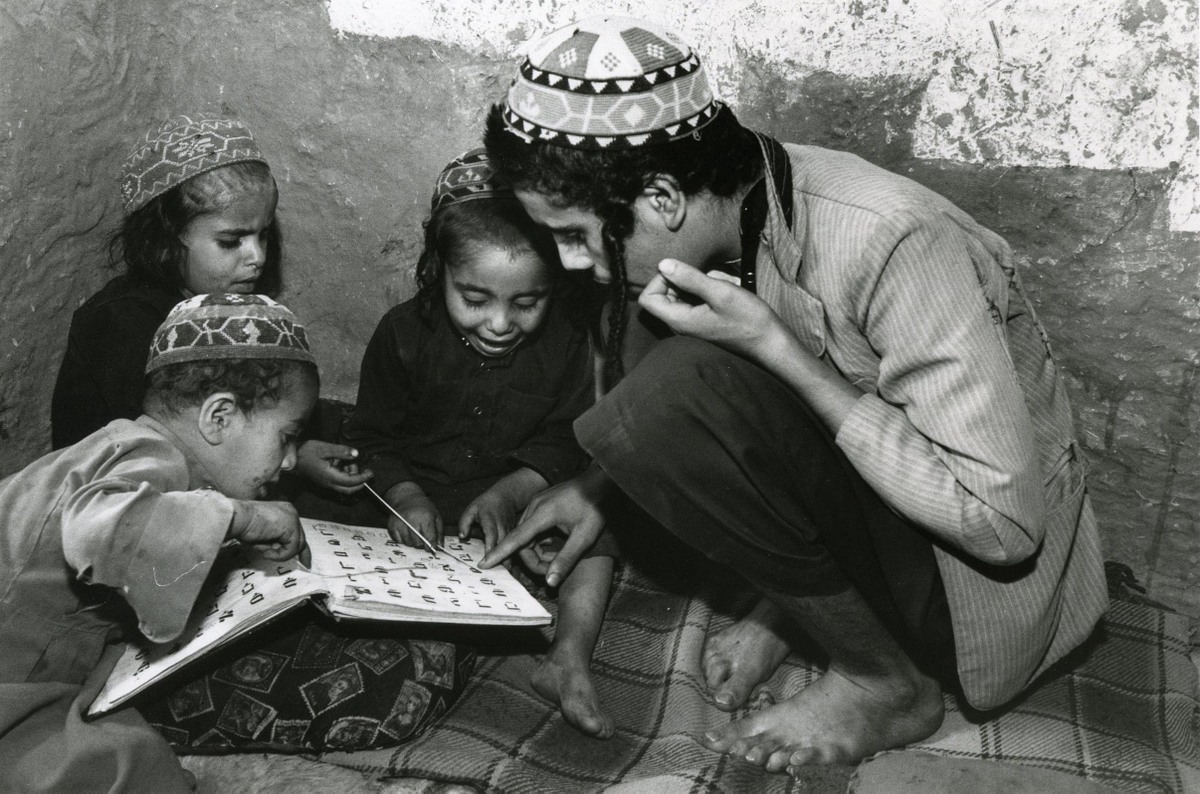
The Shape of Sound, Yemen, 1991
Whether you’re in a cave in Yemen or a yeshiva in Brooklyn, the letters of the Hebrew alphabet and the words of the Torah remain the same. It is these universal Jewish traditions that keep communities connected across time and space.
Why do you think the photographer calls this picture The Shape of Sound?
Sample Texts:
, – , ”- “ ( ,).
Ben Zoma said: Who is wise? One who learns from all people, as it is written (Psalm 119:99) “I have gained understanding from all my teachers.”
– Pirkei Avot 4:1
Rabbi Chalafta of Kefar Chanania used to say: If ten people sit together and occupy themselves with the Torah, the Divine Presence rests among them as it is written (Psalm 82:1) “God has taken his place in the divine assembly.” And from where do we learn that this applies even to five? Because it is written (Amos 9:6) “He has established his vault upon the earth.” And how do we learn that this applies even to three? Because it is written (Psalm 82:1) “He judges in the midst of the judges.” And from where can it be shown that the same applies even to two? Because it is written (Malachi 3:16) “Then those who revered the Lord spoke with one another. The Lord took note and listened.” And from where even of one? Because it is written (Exodus 20:24) “In every place where I cause my name to be remembered I will come to you and bless you.”
– Pirkei Avot 3:7
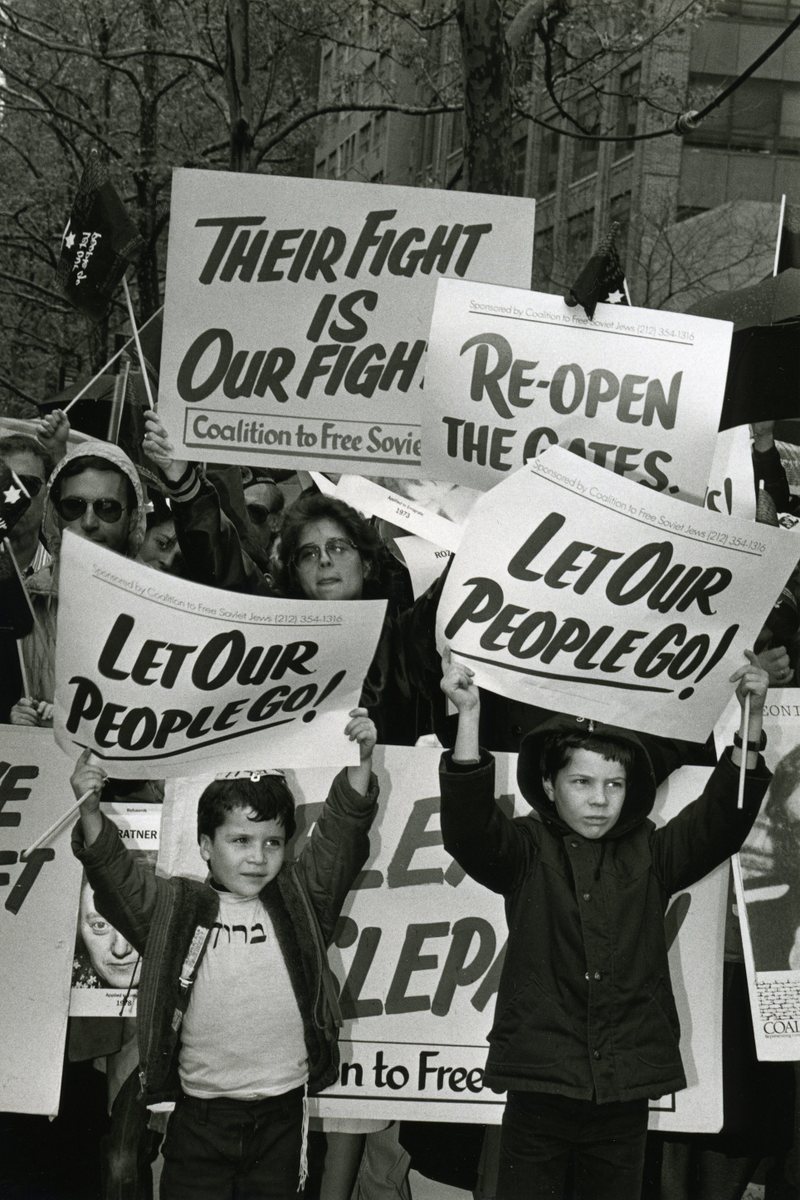
Let My People Go, New York City, 1987
These people are engaging in the important mitzvah of Pidyon Sh’vuyim (the Redeeming of Captives). At a demonstration in New York City, they push for the release of thousands of Jews from the Soviet Union. Notice what it says on the kids’ signs. Where have you heard these words before?
Under Soviet rule, Jews weren’t allowed to practice their religion. They weren’t allowed to immigrate to Israel or America, and many Jewish leaders were put in jail. To help their Jewish brothers and sisters overseas, American Jews held demonstrations, petitioned the U.S. government to pressure the Soviets, and even smuggled Jewish books and religious objects into the USSR. By the end of the 1980s, internal changes and an economic collapse in the Soviet Union, along with pressure from the world Jewish community, changed the situation for the Soviet Jews and gave them new hope. Within a few years, hundreds of thousands of Jews were able to leave the former Soviet Union for Israel.
Sample Texts:
Do not stand idly by the blood of your neighbor.
– Leviticus (Vayikra) 19:16
… … . .
When the community is in trouble do not say, “I will go home and eat and drink and all will be well with me.”…Rather, involve yourself in the community’s distress as was demonstrated by Moses (Exodus 27:12) …In this way Moses said, “Since Israel is in trouble, I will share their burden.” Anyone who shares a community’s distress will be rewarded and will witness the community’s consolation.
– Babylonian Talmud, Ta’anit 11a
There is no greater mitzvah than the redemption of captives. For a captive is among those who are hungry, thirsty, and unclothed, and he is in mortal peril. If someone pays no attention to his redemption, he violates the negative commandments: ‘Do not harden your heart or close your hand’ (Deuteronomy 15:7), ‘Do not stand by when the blood of your neighbor is in danger’ (Leviticus 19:16), and ‘He shall not oppress him with exhausting work in your presence’ (Leviticus 25:53). And he has negated the observance of the positive commandments: ‘You shall certainly open up your hand to him’ (Deuteronomy 15:8), ‘And your brother shall live with you’ (Deuteronomy 19:18), ‘Love your neighbor as yourself’ (Leviticus 19:18), ‘Save those who are taken for death’ (Proverbs 24:11), and many other decrees of this nature. There is no mitzvah as great as the redemption of captives.
– Rambam, Mishneh Torah, Hilchot Matnot Aniyim, 8:10

